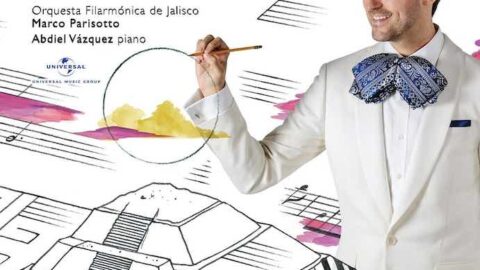Mariachitlán is a collection of high energy orchestral works by the composer Juan Pablo Contreras (b. 1987) performed by the Orquesta Filarmónica de Jalisco. Contreras’ music is both firmly rooted in Mexican and Spanish traditions as well as a part of the broader Western canon. Across Mariachitlán, Contreras contrasts a high number of musical figures that both work with and against each other. Although there are times where the sheer amount of ideas starts to feel overwhelming, the pure joy and energy that emanates from this music and Contreras’ unique use of the orchestra makes Mariachitlán highly worthy of attention.
The opening track Mariachitlán is largely music of festivity. The opening brass lines clearly evoke traditional mariachi music before giving way to a spirited dance, which almost immediately transitions to something more dissonant and jagged. Contreras doesn’t necessarily seem too concerned with producing work that is 100% Mexican in its foundation. Of course, the music pays significant homage to the music of Latin America as a whole, but it also develops and expands on those styles. Dances transition into complex and dissonant rhythmic figures. A slide whistle gives the music a cartoonish tint. While some sections of Mariachitlán teeter on the edge of falling into pastiche, Contreras ultimately synthesizes influences in a way that is always exciting and intellectually stimulating.

El laberinto de la soledad is generally more comfortable with dissonance and atonality than the preceding track, but many similar orchestral dance figures reappear. These are nicely broken up with more florid moments, which show that Contreras is as adept at writing slower spatial music as he is at writing fast-paced, energetic music. El laberinto de la soledad tends to have more in common with film music than it does with academic orchestral music, but this makes the more traditional orchestral moments that much more interesting. There’s a sudden change in the music at just about 5 minutes in which features a lively melody in the first violins with a bizarre counterpoint figure in the mallet percussion, providing yet another instance of Contreras’ ability to write exciting music that is both accessible and challenging.
The album ends with the three-movement concerto Pirámide del Sol featuring pianist Abdiel Vázquez. Throughout with concerto, the piano is used not just as a solo instrument but as a member of the orchestra that interacts with and responds to the other instruments. The first movement, “Juego de pelota,” expands on some of the ideas first developed in El laberinto de la soledad. Big and dissonant chords are played by the entire orchestra in jagged rhythms, but instead of merely repeating the figures, Contreras starts to play with the length of each phrase, which ultimately devolves into an off-kilter piano solo. “Juego de pelota” is not only a showpiece for a talented pianist, but also shows off Contreras’ exciting and interesting orchestration.

The ethereal second movement, “Ofrenda,” features one of the only moments on the entire album, let alone the concerto, where one instrument is heard by itself. After almost a half hour of non-stop orchestral energy, the slow tempo and spatial pacing of “Ofrenda” is most welcome. The final movement, “Danza emplumada,” starts with call-and-response figures between the orchestra and the piano in a basic pattern, but before long, this exchange becomes more complex with irregular phrase lengths as the orchestra and the piano start to reference previous passages. Out of all the music presented across Mariachitlán, this movement is the most homogenous in its presentation. While the other works on the album feature the juxtaposition of many different musical figures and themes, “Danza emplumada” is mostly based on a single idea. This does start to feel a little static towards the end of the work, but a very convincing performance by Vázquez keeps the music from losing too much of its forward momentum.
Mariachitlán is highly recommended listening, featuring a composer who will almost certainly be someone to watch in the next few years. Contreras’ music is as entertaining and energizing as it is intellectually stimulating. Although the works on Mariachitlán sometimes come close to doing too much of the same thing, they are performed so convincingly that it’s hard to have any real criticisms of what is truly great music.
























